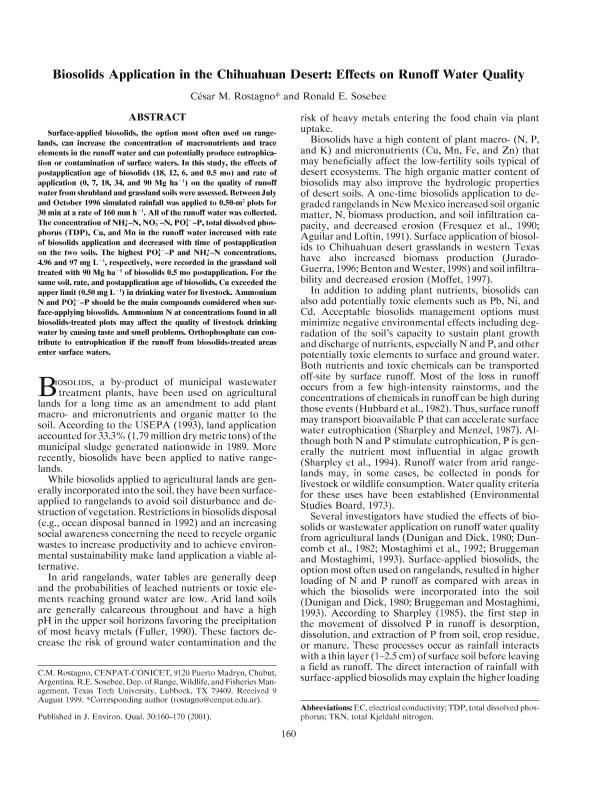Artículo
Biosolids Application in the Chihuahuan Desert: Effects on Runoff Water Quality
Fecha de publicación:
01/2001
Editorial:
American Society of Agronomy
Revista:
Journal of Environmental Quality
ISSN:
0047-2425
e-ISSN:
1537-2537
Idioma:
Inglés
Tipo de recurso:
Artículo publicado
Clasificación temática:
Resumen
Surface-applied biosolids, the option most often used on rangelands, can increase the concentration of macronutrients and trace elements in the runoff water and can potentially produce eutrophication or contamination of surface waters. In this study, the effects of postapplication age of biosolids (18, 12, 6, and 0.5 mo) and rate of application (0, 7, 18, 34, and 90 Mg ha21) on the quality of runoff water from shrubland and grassland soils were assessed. Between July and October 1996 simulated rainfall was applied to 0.50-m2 plots for 30 min at a rate of 160 mm h21. All of the runoff water was collected. The concentration of NH4 –N, NO2 3 –N, PO32 4 –P, total dissolved phosphorus (TDP), Cu, and Mn in the runoff water increased with rate of biosolids application and decreased with time of postapplication on the two soils. The highest PO32 4 –P and NH 4 –N concentrations, 4.96 and 97 mg L21, respectively, were recorded in the grassland soil treated with 90 Mg ha21 of biosolids 0.5 mo postapplication. For the same soil, rate, and postapplication age of biosolids, Cu exceeded the upper limit (0.50 mg L21) in drinking water for livestock. AmmoniumN and PO32 4 –P should be the main compounds considered when surface-applying biosolids. Ammonium N at concentrations found in all biosolids-treated plots may affect the quality of livestock drinking water by causing taste and smell problems. Orthophosphate can con-tribute to eutrophication if the runoff from biosolids-treated areas enter surface waters.
Archivos asociados
Licencia
Identificadores
Colecciones
Articulos(CCT-CENPAT)
Articulos de CTRO.CIENTIFICO TECNOL.CONICET - CENPAT
Articulos de CTRO.CIENTIFICO TECNOL.CONICET - CENPAT
Citación
Rostagno, Cesar Mario; Sosebee, Ronald E.; Biosolids Application in the Chihuahuan Desert: Effects on Runoff Water Quality; American Society of Agronomy; Journal of Environmental Quality; 30; 1; 1-2001; 160-170
Compartir
Altmétricas




